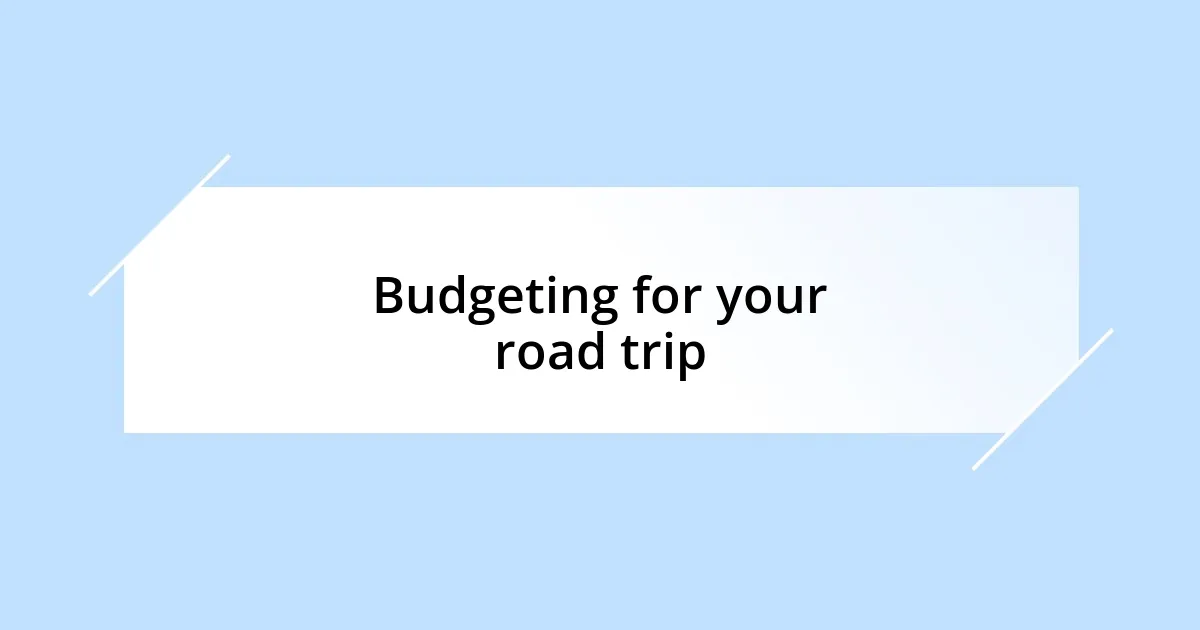Key takeaways:
- Researching routes revealed hidden gems, transforming the journey into an adventure rather than just focusing on the destination.
- Creating a detailed itinerary with flexibility allowed for spontaneous experiences, enhancing the overall trip enjoyment.
- Establishing a comprehensive budget helped manage expenses and opened up opportunities for memorable unplanned activities.
- Preparing the vehicle and updating the emergency kit ensured a safe and stress-free travel experience.

Researching the best routes
When I embarked on planning my dream road trip, researching the best routes felt like embarking on an adventure of its own. I poured over maps, travel blogs, and local guides, dreaming not just of reaching a destination, but of the experiences that awaited me along the way. How often do we overlook the beauty of the journey itself in our rush to get to the end?
I remember one particularly exciting moment when I stumbled upon a scenic byway that promised breathtaking views of rolling hills and quaint towns. I had to ask myself, would I rather hurry along a highway or savor every twist and turn of a lesser-known road? That simple choice transformed my trip into a treasure hunt, revealing hidden gems I would have otherwise missed.
As I plotted my itinerary, I began to appreciate how technology amplified my research efforts. Apps that highlighted local attractions, restaurants, and even rest stops helped me create a route that wasn’t just practical but also enriching. Each pause to explore a roadside mural or a charming café filled me with an unexpected joy—confirming that sometimes, the best routes are those that take us off the beaten path.

Creating a detailed itinerary
Creating a detailed itinerary was an essential part of my preparation. I wanted to go beyond a basic plan; I aimed for something that captured the spirit of adventure. I can’t stress enough how important it is to account for the unexpected. I made sure to include flexible time slots, allowing for spontaneous detours. That flexibility proved invaluable when I discovered an unplanned local festival, turning an ordinary stop into a night I’ll cherish forever.
Here’s a quick look at what I included in my itinerary:
- Key destinations: Mark significant stops based on your interests and research.
- Time estimates: Allocate realistic travel times, allowing for breaks and exploration.
- Alternate routes: Identify backup paths in case of detours or road closures.
- Local experiences: Research unique attractions, dining options, and hidden gems along the way.
- Emergency contacts: List roadside assistance numbers, local emergency services, and accommodation options.
This approach ensured that my adventure felt carefully curated yet wonderfully spontaneous, embracing both planning and the thrill of the unknown.

Budgeting for your road trip
Budgeting for your road trip is a vital step that can make or break your adventure. I remember the first time I set out on a long drive; I didn’t really give my budget much thought, and it quickly became a source of stress. After that trip, I learned to break down my expenses into clear categories. This way, I could track my spending and ensure that I had enough funds for both planned activities and unexpected thrills—because let’s face it, the unplanned moments often create the best memories!
To get a handle on my budget, I created a simple table to compare different expenses. Fuel, accommodation, food, and attractions each need careful consideration. For example, if you’re driving through national parks, entrance fees can add up quickly, so purchasing a park pass ahead of time can save you some cash. I’ve found that budgeting for fun experiences—like a guided tour or unique dining options—can transform a good trip into a great one. Remember, it’s about finding the right balance between budgeting and enjoying the ride!
Here’s a breakdown of what I typically include when budgeting for a road trip:
| Expense | Estimated Cost |
|---|---|
| Fuel | $150 |
| Accommodation | $600 |
| Food | $300 |
| Attractions | $200 |
| Miscellaneous | $100 |
By keeping a detailed budget, I ensure that I can afford my road trip desires without worrying about financial constraints. This approach has truly changed how I view my journeys—turning potential stress into excitement!

Preparing your vehicle for travel
Ensuring your vehicle is road-ready is a cornerstone of the travel experience. I remember my excitement before embarking on a solo trip, only to realize I hadn’t checked my tires. That moment of panic when I noticed one was getting thin taught me a valuable lesson: never underestimate the basics. I always recommend performing a comprehensive check-up that includes oil levels, tire pressure, brakes, and fluid levels. It might seem tedious, but a well-maintained vehicle can make all the difference during long stretches on the open road.
Another crucial step is to update your emergency kit. I vividly recall a flat tire on a desolate highway. Thankfully, I had my kit ready with essentials like a flashlight, jumper cables, and even snacks! This experience underscored how preparation can turn potential disasters into mere inconveniences. Don’t forget to add a first-aid kit too. It’s all about feeling secure, knowing you’re equipped for the unexpected.
Lastly, I always suggest a good clean-out of your vehicle before hitting the road. It might seem trivial, but decluttering your space makes your drive more enjoyable. On my last trip, I found that the absence of old snacks and random items really created a more comfortable atmosphere. Isn’t it more relaxing to have a tidy car where you can focus on enjoying the scenery rather than searching for that lost travel mug? A clean vehicle truly enhances the overall adventure!













